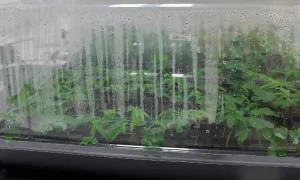How to Increase Humidity for Plants? 8 Best Tips to Maintain Humidity for Plants in Indoor: Humidity plays as big a role in our health and well-being as it does in plants. As a rule, however, plants need higher humidity than we humans do. Especially in winter when the heating air is dry, houseplants suffer and show this by dry leaves and leaf tips. In general, most houseplants do well with a humidity of 40%. Plants originally from tropical or subtropical regions need a humidity of about 60%. These values are rarely reached in heated rooms. But ideal temperature & humidity for plants are needed. We’ll show you how to achieve the ideal temperature and how to increase the humidity for plants.
Contents
- Absolute and Relative Humidity
- Humidity is Important for Indoor Plants
- Disadvantages of Too Dry Air
- How to Increase Humidity for Plants? 8 Best Tips
- 1. Arrange plants in groups
- 2. Spray plants
- 3. Put plants in the bathroom
- 4. Bowls with pebbles and water
- 5. Drying laundry in the room
- 6. Put bowls with water on the heater
- 7. Lower the room temperature
- 8. Increase humidity with a humidifier
- How Can You Tell If the Humidity in Your Home Is Too Low?
- Final Thoughts: How to Increase Humidity for Plants?
- How can I raise the humidity in my plants without a humidifier?
- How do I keep my plants humid in the winter?
- Can plants reduce humidity?
Absolute and Relative Humidity
A distinction is made between absolute and relative humidity. Relative humidity is important for our well-being. Absolute humidity indicates how much water vapor is contained in one cubic meter of air. When the maximum value that the air can absorb is reached, the water condenses.
You can recognize this by the fact that small air droplets or a film of water condense on the glass panes, for example. Relative humidity is the ratio between absolute humidity and the maximum amount the air can actually absorb, taking temperature into account. Relative humidity depends on temperature since warm air can absorb more water vapor than cold air.
To illustrate, if the humidity in a room remains constant and the room temperature increases, the relative humidity decreases because warm air could absorb more moisture. The absolute humidity, however, remains the same. When we talk about humidity here, we mean relative humidity.
Humidity is Important for Indoor Plants
Why humidity is important for indoor plants? Well, during photosynthesis, the pores on the plant’s leaves, called stomata, open to allow gas exchange. In the process, the plant releases moisture. The drier the room air, the more moisture the plant evaporates. If the plant loses too much moisture in the process, the plant’s leaves may dry out or become shriveled. The first sign that the room air is too dry is dried-up tips of the leaves. This is also the reason why plants help to increase humidity in rooms. In addition, houseplants are more susceptible to pests when the air is dry.
Houseplants vary in their sensitivity to excessively dry air. As a rule of thumb, plants with firm, leathery leaves tolerate dry air better than plants that have thin, delicate leaves. Especially for the sensitive plants that suffer from dry heating air or are located at a sunny window, you should increase the humidity.
Disadvantages of Too Dry Air
Not only the plants but also, we humans suffer from too dry air. Dry skin, itchy skin, or headaches can be the result. But not only people and plants suffer. Wooden objects can also become deformed or cracked. Another sign of too-dry indoor air is when more dust is found in the apartment.
Read more about How to increase nitrogen in soil?
How to Increase Humidity for Plants? 8 Best Tips
1. Arrange plants in groups
Plants release moisture into the environment through their pores. This means that near them, the humidity is higher. If you arrange plants in groups, the plants can benefit from the evaporated moisture of the others. The disadvantage of this option is that you need a lot of plants. This is often not possible or desirable.
2. Spray plants
Spraying plants with water from an atomizer increases humidity for a few hours. It is the best way to increase humidity for plants without a humidifier. You should spray the plants and their surroundings in the morning when the heating and the sun warm up the room. This method of increasing humidity is simple and cheap, but it has the disadvantage that it works only for a short time.
3. Put plants in the bathroom
Many houseplants benefit from the humid air in the bathroom, especially those that need high humidity. Even after showering, humidity remains high in bathrooms because water remains in the sink or shower tray and slowly evaporates. Damp towels also increase humidity.
Tip: After showering, open the bathroom door to the apartment rather than the window. This will increase the humidity in the other rooms.
4. Bowls with pebbles and water
A good way to increase the humidity in your plants is to place them on a tray filled with pebbles. The pebbles should still be sticking out of the water so that the plant pots are not in contact with the water. The water in the bowl evaporates slowly and increases the humidity in the immediate vicinity of the plant. You will achieve the best effect if the diameter of the bowl is as large as the plant’s total width. If you don’t like this option, you can also put the houseplant in a larger planter and fill the bottom of the planter with pebbles and water. However, the wider the water bowl or planter, the greater the effect. So you don’t have to add water so often, the bowl should be at least four inches high.
5. Drying laundry in the room
Place your clothes dryer in the room with the most indoor plants. Drying the laundry will increase the humidity of the air
6. Put bowls with water on the heater
The water in the trays will evaporate and increase the humidity in the room.
7. Lower the room temperature
The cooler a room is, the higher the relative humidity. You can therefore increase the humidity if you turn down the heating a little, for example, in your absence.
8. Increase humidity with a humidifier
Humidity can be increased comfortably and reliably with a humidifier. The disadvantage of this method is that the device consumes energy and resources during operation and production. Therefore, it is necessary to consider whether such a purchase is necessary. If you decide to buy a humidifier, pay attention to whether the size of the room fits the power of the device.
Note: Too much humidity for plants is dangerous. The humidity must not be higher than 70% in the home to avoid mold growth. The frequent airing of the apartment is also important for a healthy indoor climate. Do not just tilt the windows, but open them wide for short periods. You should air your apartment in this way two to four times a day. Do not forget to turn down the heating while airing.
How Can You Tell If the Humidity in Your Home Is Too Low?
Dry skin, itchy eyes, and brown tips on the leaves of indoor plants – are all indications that the indoor air is too dry. If you want to measure humidity accurately, you should buy a hygrometer. With it, you can measure the humidity in your home.
Final Thoughts: How to Increase Humidity for Plants?
Learn more about When should I add molasses to my plants?
Plants suffer from the same “disease” as many of their human companions. They would rather be in the warmth at the beach right now than in their apartment. Many houseplants actually come from tropical or subtropical regions and are therefore used to long, hot days. Also, in these regions, there is the humidity that would constantly drive beads of sweat on our foreheads.
The plants have to deal with completely different problems in different climates such as cold and little sunlight in winter, dry heated air, and low humidity. In this article, we have shown the 8 best ways how to increase the humidity for plants. Hope the tips will blow away your tension regarding humidity maintenance for your plants.
Frequently Answered Questions
How can I raise the humidity in my plants without a humidifier?
There are a number of ways like regularly spraying with water, avoiding hot spots for plants, growing them under glass, etc.
How can I naturally humidify my plants?
One way is to place your plants closer to one another to increase air humidity. You can also add pebbles with water in a tray as well.
How do I keep my plants humid in the winter?
You can keep the humidity for plants indoors by placing them closer to windows and dusting them off once in a while.
Can plants reduce humidity?
In a way, yes. Plant foliar uptake is responsible for absorbing humidity, fog, or dew that creates moisture.




